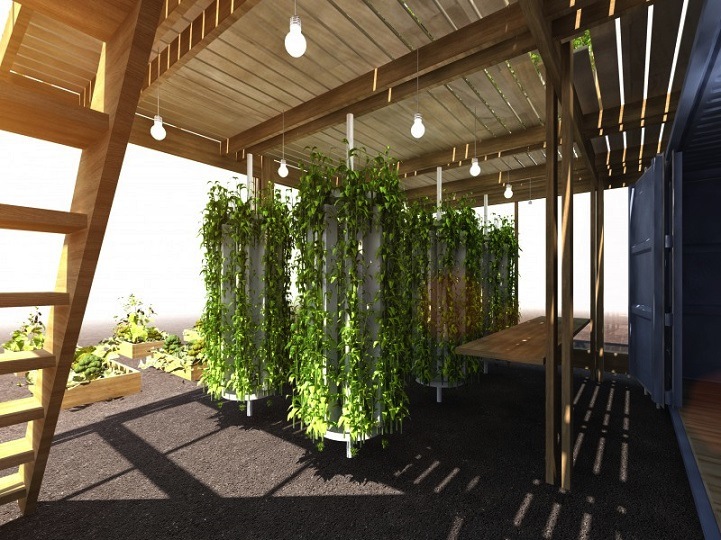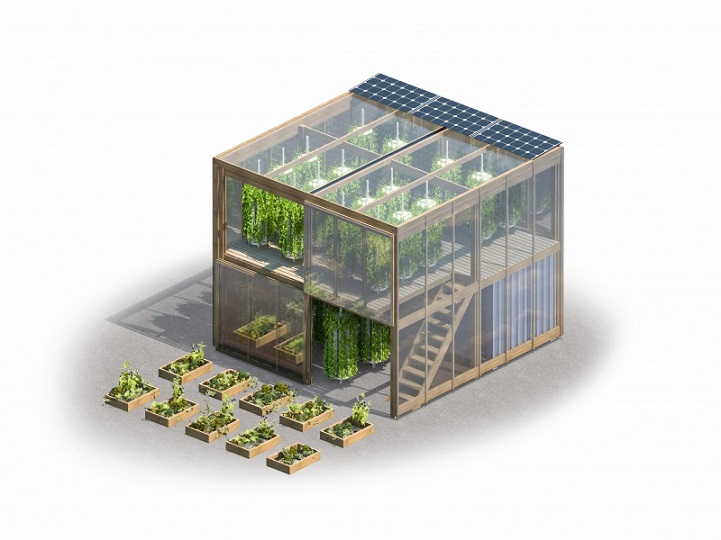Human Habitat, a Copenhagen-based urban design lab, thinks it has solved one of the problems nagging urban food production—limited space—with its Impact Farm, an easy-to-transport and -assemble hydroponic grown garden that’s designed to help rescue urban communities from their fresh-produce scarcities.
“We wanted to make urban farming even smarter,” Ronnie Markussen, one of Human Habitat’s founders, told Collectively.org, a website that reports on new ideas for the urban environment. The goal, he went on, is to increase food security in cities, lower the ecological footprint of food production, create jobs, and easily adapt to changes in the urban landscape.
“We wanted to reconnect people to food by giving them a green space that brings nature back into our cities,” said Human Habitat’s cofounder Mikkel Kjaer.
All of the construction components for Impact Farm, along with an instruction booklet, are stored and shipped in a flatpack container. When unpacked, the container includes an assembly kit of pre-made materials that become a two-story vertical, soil-free, hydroponic farm that covers 538 sf.
Construction takes about 10 days. And the structure can just as easily be disassembled and moved to another location. “The foundation of our design is C2C [cradle-to-cradle] and the circular economy,” the company states. “We use materials that are either re-used or designed to circulate within the production circle.” The whole structure is designed to be self-sufficient in terms of water, heat and electricity by harvesting sun and wind, and collecting rainwater. Future farms may adopt aquaponics.
Impact Farm is designed to create an economically sustainable business model that ensures resource-efficient local food production, green jobs, and increased local economic activity. The facility can grow greens, vegetables, herbs, and fruiting plants within its frame.

Currently, a prototype is being tested in Copenhagen’s Norrebro neighborhood, and Human Habitat’s Kjaer and Markussen intend to offer their product for sale to large cities in the United States and other parts of the world.
Circulate News and Collectively.org report that the innovators envision a number of different buyers of the farm, including housing co-ops, restaurants, schools, and municipalities.
Kjaer and Markussen estimate that the Impact Farm—which is meant to be a temporary structure—could produce 3-6 tons of food per year commercially, depending on crop combinations. The founders told Collectively.org that a larger, community-driven project—such as one seeking to produce vegetables, leafy greens and fruit for distribution to schools, kindergartens and nursing homes—could expect to produce up to just over 6 tons per year.
Initial retail costs are still being estimated.
Related Stories
| Jul 10, 2014
New tool aggregates LEED project info for over 150 countries
The U.S. Green Building Council announced the launch of an expanded online data visualization resource that will allow any user to access aggregated LEED green building project information in the more than 150 countries with LEED projects.
| Jul 2, 2014
Emerging trends in commercial flooring
Rectangular tiles, digital graphic applications, the resurgence of terrazzo, and product transparency headline today’s commercial flooring trends.
| Jun 30, 2014
4 design concepts that remake the urban farmer's market
The American Institute of Architects held a competition to solve the farmer's markets' biggest design dilemma: lightweight, bland canopies that although convenient, does not protect much from the elements.
| Jun 30, 2014
OMA's The Interlace honored as one of the world's most 'community-friendly' high-rises
The 1,040-unit apartment complex in Singapore has won the inaugural Urban Habitat award from the Council on Tall Buildings and Urban Habitat, which highlights projects that demonstrate a positive contribution to the surrounding environment.
| Jun 19, 2014
First Look: 10 Design unveils new luxury apartments plan in Dubai
The Seventh Heaven complex features a stepped form that will offer stunning views of the Dubai skyline.
| Jun 19, 2014
Singapore's 'Tree House' vertical gardens break Guinness World Record
The high-rise development will have a 24,638-sf vertical garden, breaking a Guinness World Record.
| Jun 18, 2014
Largest Passive House structure in the U.S. to be built in Oregon
Orchards at Orenco, a 57-unit affordable housing complex in Hillsboro, Oregon, is the first of a three-phase, three-building complex.
| Jun 12, 2014
SmithGroup finishes 100th LEED-certified project
With the construction of the LEED-NC Platinum Oakland University Human Health Building, constructed in Rochester, Michigan, SmithGroupJJR recently achieved its 100th LEED certified project.
| Jun 11, 2014
David Adjaye’s housing project in Sugar Hill nears completion
A new development in New York's historic Sugar Hill district nears completion, designed to be an icon for the neighborhood's rich history.
| Jun 2, 2014
Parking structures group launches LEED-type program for parking garages
The Green Parking Council, an affiliate of the International Parking Institute, has launched the Green Garage Certification program, the parking industry equivalent of LEED certification.

















